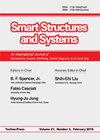Energy dissipation by friction for sliding blocks subjected to near-fault seismic base motion
IF 2.2
3区 工程技术
Q2 ENGINEERING, CIVIL
引用次数: 1
Abstract
The objective of this study was to determine friction ratios that maximize energy dissipation on a seismic damper. The aforementioned friction damper basically consists of mass blocks that are able to slide on a flat surface. To carry out this analysis, a numerical-experimental approach was used. Firstly, the theoretical background and equations of motion for a SDOF system consisting of a mass supported on a flat surface with friction are introduced. Special emphasis is made on the fundamentals of stick-slip motion as well as energy considerations. Secondly, experimental studies carried out on a shaking table with harmonic and seismic records are described. These tests consisted of lead blocks contained on a U-shaped channel type aluminum section with its open end facing upwards. This configuration allowed blocks to slide solely in the direction of the base motion. Five different types of contact interfaces were considered to determine potential friction coefficients for the damper's design. Additionally, computational models based on rigid-body dynamics are presented. Numerical results were satisfactory particularly when comparing model's dissipated energy with empirical results. An analysis was carried out by calculating dissipated energy for the experimentally-calibrated models with varying friction ratios. For this purpose, eight near-fault seismic records were selected. Intervals with friction coefficients that maximize energy dissipation are proposed for each record. Finally, relationships between the computed friction ratios and register's peak ground acceleration (PGA) and root mean square acceleration (RMS) are discussed.近断层地震基底运动下滑动块体的摩擦耗散
本研究的目的是确定摩擦比,最大限度地耗散能量的地震阻尼器。上述摩擦阻尼器基本上由能够在平面上滑动的质量块组成。为了进行这种分析,采用了数值-实验方法。首先,介绍了基于摩擦的平面支撑质量的单自由度系统的理论背景和运动方程。特别强调粘滑运动的基本原理以及能量方面的考虑。其次,介绍了在具有谐波记录和地震记录的振动台上进行的试验研究。这些测试包括铅块包含在u形槽型铝截面上,其开口端朝上。这种结构允许块只在基础运动的方向上滑动。考虑了五种不同类型的接触界面,以确定阻尼器设计的潜在摩擦系数。此外,还提出了基于刚体动力学的计算模型。数值结果令人满意,特别是将模型的耗散能与经验结果进行了比较。通过计算不同摩擦比下实验标定模型的耗散能进行了分析。为此,选取了8条近断层地震记录。对每条记录提出了摩擦系数最大的能量耗散间隔。最后,讨论了计算出的摩擦比与寄存器的峰值地面加速度(PGA)和均方根加速度(RMS)之间的关系。
本文章由计算机程序翻译,如有差异,请以英文原文为准。
求助全文
约1分钟内获得全文
求助全文
来源期刊

Smart Structures and Systems
工程技术-工程:机械
CiteScore
6.50
自引率
8.60%
发文量
0
审稿时长
9 months
期刊介绍:
An International Journal of Mechatronics, Sensors, Monitoring, Control, Diagnosis, and Management airns at providing a major publication channel for researchers in the general area of smart structures and systems. Typical subjects considered by the journal include:
Sensors/Actuators(Materials/devices/ informatics/networking)
Structural Health Monitoring and Control
Diagnosis/Prognosis
Life Cycle Engineering(planning/design/ maintenance/renewal)
and related areas.
 求助内容:
求助内容: 应助结果提醒方式:
应助结果提醒方式:


